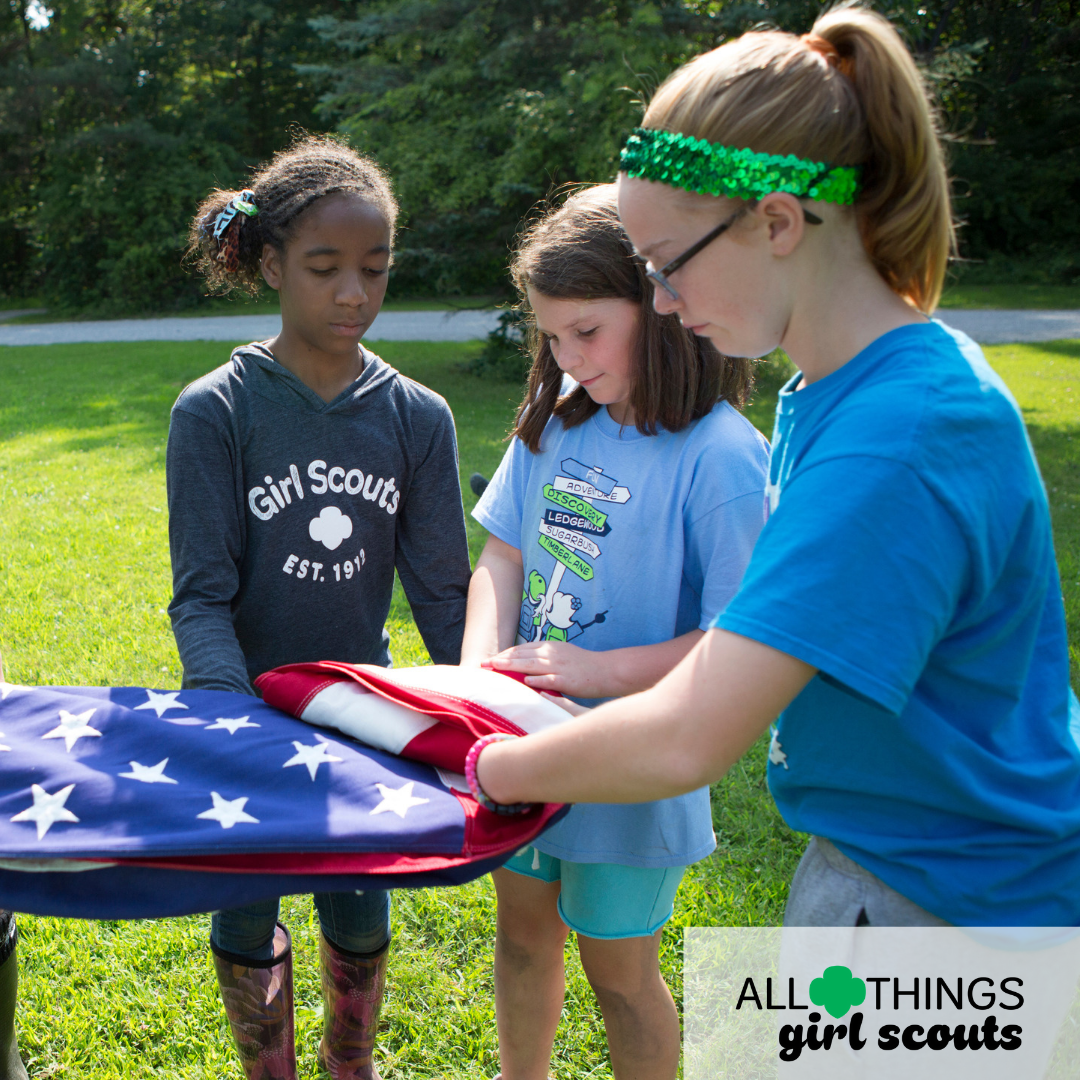Flag ceremonies are often part of a larger ceremony or event. Some troops host a flag ceremony at every troop meeting. Others troops reserve ceremonies for big, important days like bridging ceremonies or end of year celebrations. At camp, a flag ceremony often starts and ends each day. Most of our flag ceremonies aren’t perfect, and that’s ok. Girls are learning and practicing how it’s done, which means mistakes will be made. Your goal as a volunteer is to set the tone and provide guidance to complete the ceremony.
Our flag ceremony reminders in this article are for ceremonies hosted around a flagpole, such as at summer camp. In this case, a folded flag is brought to the flagpole, and raised in the morning or beginning of the event, and retired in the evening or at the end of the event. These take place most frequently at camp, but you might find opportunities to do them at your school or for civic ceremonies.
Make a plan
There are a few decisions you will want to make before the ceremony. You’ll want to inspect the flagpole to make sure all the clips are working, and you will want to make sure you have a flag that is the correct size for the clips. You also want to decide what you want to include during the ceremony. For instance, determine whether you want to add the Girl Scout Promise or Law after the Pledge of Allegiance, or include a poem or song.
Prepare the Girls
Girls have different roles to fill during the ceremony. Each girl needs to know what she is responsible for doing, and what her cues are. You’ll want to set aside time to practice before the ceremony. Let’s look at the roles.
The color bearer (or flag bearer) is the person who carries the flag. During an opening ceremony, this girl will walk forward holding the folded flag with color guards behind her. She will pass them the flag, undo the rope from the pole, clip it onto the flag, and raise the flag. During a closing ceremony, she will bring the flag down the pole, and after it’s folded, will carry it away from the flagpole.
The color guard is a team that guards the flag(s). Any even number of guards may be used, but usually four or six girls are sufficient. During the opening ceremony, the color guard walks behind the color bearer. When passed the flag, they unfold it and hold it as it is raised until they can be certain it is high enough to not touch the ground. During a closing ceremony, they are passed the flag as it reaches them, and they fold it. Folding is a team effort, but the girls doing most of the folding are placed in the back of the line. Be sure girls have a chance to practice folding before the ceremony. And remember, they are learning. Sometimes stage-fright gets the best of them and the folding might not be perfect. You can always refold it after the ceremony, preparing for next time.
The Girl Scout in charge (or caller) is a designated Girl Scout who announces or calls each part of the ceremony. You’ll find an example of ceremony commands at GSUSA’s website.
Plan Reminders for the Audience
Because these ceremonies often happen at camp, your audience will be primarily other girls. Be sure to give them reminders like to remove any non-religious headgear (such as baseball caps) or how to make a horseshoe around the pole. If you sing a song, like Taps, during your ceremony, consider teaching it ahead of time.
Get to Know the United States Flag Code
Display of the American flag is governed by law to ensure that it will be treated with the respect due the flag of a great nation. This is known as the United States Flag Code. Some of the rules most useful for Girl Scouts posting the flag on a pole are:
The flag should never be allowed to touch anything beneath it, nor should it ever be carried flat or horizontally—always aloft and free.
The flag should be hoisted briskly and lowered ceremoniously.
When flown at half-staff, the flag should be first hoisted to the top for an instant and then lowered to the half-staff position. When retiring at the end of the day, the flag should again be raised to the top before it is lowered.
During the ceremony of hoisting or lowering the flag all non-military persons should face the flag and stand at attention with the right hand over the heart, or if applicable, remove their headdress with their right hand and hold it at the left shoulder, the hand being over the heart. Citizens of other countries present should stand at attention.
It is the universal custom to display the flag only from sunrise to sunset on buildings and on stationary flagstaffs in the open. However, when a patriotic effect is desired, the flag may be displayed 24 hours a day if properly illuminated during hours of darkness.
The flag should not be displayed on days when the weather is inclement, except when an all weather flag is displayed.
 Featured
Featured



